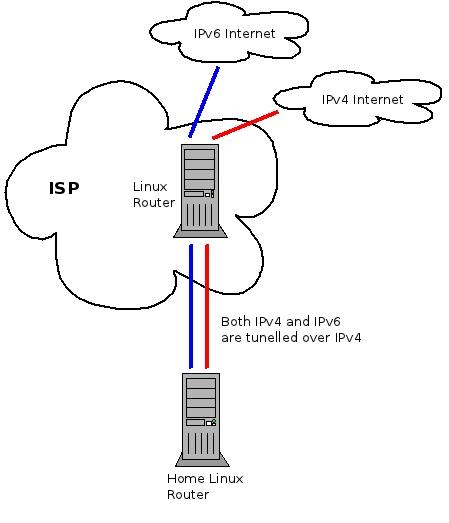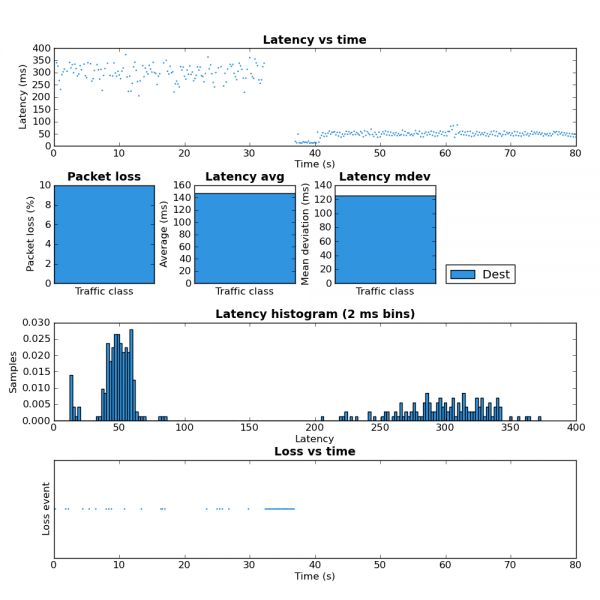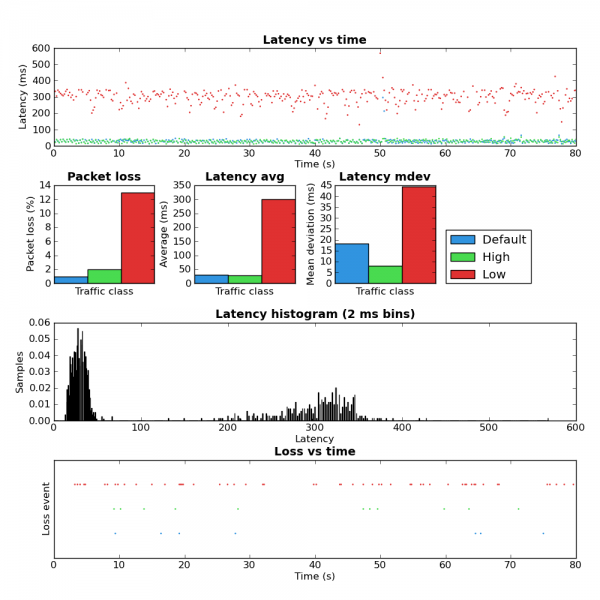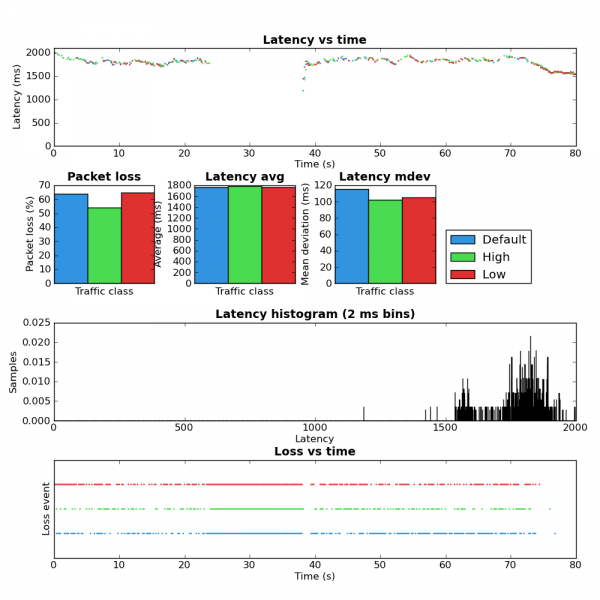System virtualization moves the edge of the network
One of the biggest innovations of the Internet was moving the intelligence from the network to the edge devices. Making the end host responsible for data delivery and creating a network architecture that is application agnostic were radical and incredibly successful ideas. Although much of the architecture made this switch the demarcation between the network owner and its users forced some features such as access control and provisioning to remain in the access routers and switches. Given the relationship of consumers to their service providers this will probably never change in the consumer Internet market but something very interesting is happening within data centres due to virtualization.
Moving to the Edge: An ACM CTO Roundtable on Network Virtualization
One of the most interesting ideas in the discussion linked to above is that the advent of system virtualization necessarily moves the point of enforcement, or intelligence, from the network access layer into the host itself. This comes in the form of the networking features of hypervisors. Hypervisors implement switching and routing but what’s really interesting is that they are also the best location for functions such as firewalls because implementing these functions as separate devices greatly limits the flexibility of the virtualized data centre. Imagine migrating a VM anywhere the data center and having its firewall rules follow automatically to the new host vs having to choose amongst N hosts which are behind the same firewall.
Two groups may be affected greatly by this change: network equipment vendors and IT networking professionals.
I do not believe that owners of existing network infrastructure need to worry about the hardware they already have in place. Chances are your existing network infrastructure provides adequate bandwidth. Longer term, networking functions are being pulled into software, and you can probably keep your infrastructure. The reason you buy hardware the next time will be because you need more bandwidth or less latency. It will not be because you need some virtualization function. (Martin Casado)
The above argues that existing network switches and routers are already good enough for this new architecture. That is, networking equipment will become further commoditized which may not be good from the perspective of Cisco and other equipment vendors.
What about switch and router experts?
The people who will be left out in the cold are the folks in IT who have built their careers tuning switches. As the edge moves into the server where enforcement is significantly improved, there will be new interfaces that we’ve not yet seen. It will not be a world of discover, learn, and snoop; it will be a world of know and cause. (Lin Nease)
and
There’s a contention over who’s providing the network edge inside the server. It’s clearly going inside the server and is forever gone from a dedicated network device. A server-based architecture will eventually emerge providing network-management edge control that will have an API for edge functionality, as well as an enforcement point. The only question in my mind is what will shake out with NICs, I/O virtualization, virtual bridges, etc. Soft switches are here to stay, and I believe the whole NIC thing is going to be an option in which only a few will partake. The services provided by software are what is of value here, and Moore’s law has cheapened CPU cycles enough to make it worthwhile to burn switching cycles inside the server.
If I’m a network guy in IT, I better much more intensely learn the concept of port groups, how VMware, Xen, etc. work, and then figure out how to get control of the password and get on the edge. Those folks now have options that they have never had before.
The guys managing the servers are not qualified to lead on this because they don’t understand the concept of a single shared network. They think in terms of bandwidth and VPLS (virtual private LAN service) instead of thinking about the network as one system that everybody shares and is way oversubscribed. (Lin Nease)
Of course networking experts will still be required but this new world may involve spending a lot more time managing servers than at the router/switch CLI.
The simple network continues to win.
Making the Linux flow classifier tunnel aware
Flow Classifier
The Linux kernel has many different tools for managing traffic. One of them is the flow classifier which allows the user to configure which fields of the packet headers should be used to create a hash which is then used to identify flows and manage them. For example, if the user selects src,dst,proto,proto-src,proto-dst they get a unique value for each flow (within the limits of the hash). Alternatively, using only src as the key will result in all flows being grouped by the source IP address.
The Problem
Below is a slightly simplified version of my home network.
All of the traffic, both IPv4 and IPv6, is tunnelled through a Linux router which lives at my service provider. The reason for this complicated setup is that it gives me control of the traffic in both the upstream and downstream. By shaping the traffic to just below the maximum rate in each direction I am able to avoid Bufferbloat problems and prioritize latency sensitive traffic such as SSH, DNS and Vonage. Especially under load, my QoS scripts make marked difference in how fast the Internet feels.
The multiple tunnels present a problem for implementing my QoS scheme because from the perspective of the underlying interface there are only two flows on the network. One for the IP-IP tunnel and one for the IP-IPv6 tunnel. A work around I used for a while was to apply the QoS rules to the IP-IP tunnel interface because that’s where the bulk of the traffic flows. However, this meant that IPv6 traffic was not properly controlled and any time I had a significant amount of IPv6 traffic I lost all the advantages of my QoS scheme.
To solve this properly I needed a way to look into the tunnels in order to identify the inner network flows. So I’ve extended the flow classifier with the keys in the following table. IP-IP, IP-IPv6, IPv6-IP and IPv6-IPv6 tunnels are supported.
| Key | Description |
| tunnel-src | Extract the source IP from the inner header |
| tunnel-dst | Extract the destination IP from the inner header |
| tunnel-proto | Extract the protocol from the inner header |
| tunnel-proto-src | Extract the transport protocol source port from the inner header |
| tunnel-proto-dst | Extract the transport protocol destination port from the inner header |
Results
In order to validate that this works I started a couple SCP uploads to max the upstream bandwidth and then ran ping-exp to measure the latency. At the start of the test the flow classifier keys were src,dst,proto,proto-src,proto-dst. Approximately half way through I changed the keys to src,dst,proto,proto-src,proto-dst,tunnel-src,tunnel-dst,tunnel-proto,tunnel-proto-src,tunnel-proto-dst. The advantage of keeping the non-tunnel keys is that any traffic created by the router itself is still classified properly. Here is the tc script I used. You can see the results of this test in the figure 2 below.
For the first half of the test you can see the high latency. This is due to all the traffic from the SCP upload and ICMP pings being placed into the same queue because from the perspective of the flow classifier there is only one flow. In the second half of the test the addition of the tunnel keys allows the flow classifier to place the ICMP packets into a different queue which is not affected by the SCP upload and therefore has much lower latency. The large amount of packet loss during the key change is because the script I used creates a large number of queues. While these queues are being created packets are dropped.
While my network setup may be a bit unique I think it’s likely that many home networks will have some form of tunnelling in the near future as tunnels are part of several IPv6 migration strategies. So hopefully this little addition will be useful in many different contexts.
Below are links to the two patches that are required. I’ll post them to Netdev for review shortly.
Linux flow classifier proto-dst and TOS
Recently I’ve been playing around with the Linux flow classifier on my gateway. The flow classifier provides the ability to group network flows by configuring which parts of the packet headers (referred to as keys) are used in a hash calculation which chooses the output queue.
All of my Internet traffic travels over an IPIP tunnel to another Linux box. I do this so I have control of the QoS in both the upstream and the downstream. A result of this configuration is that from the perspective of the output interface there is only a single network flow.
I configured the flow classifier to use the src,dst,proto,proto-src,proto-dst keys which aims to provide 5-tuple flow fairness. Here’s the simple tc script I used. Due to the IPIP tunnel I expected to see that all traffic would be placed into the same queue. Strangely, the below is what my little ping-exp utility showed when running at the same time as an SCP upload.
Coincidentally I ran ping-exp configured to send three different streams of ICMP traffic with different IP TOS values. Note that SCP automatically sets the IP TOS to the equivalent of the “Low” stream in the test.
Notice that the pings using the high and default TOS values appear to be unaffected by low priority ping and SCP traffic. This was unexpected because none of src,dst,proto,proto-src or proto-dst keys should be affected by the TOS value.
After a bit of experimentation I determined that the proto-dst key was the source of the problem. If you spend a bit of time with the flow_get_proto_dst() function in cls_flow.c you’ll see that if the protocol is ICMP or IPIP, as it is in my test, then the following value is returned:
return addr_fold(skb_dst(skb)) ^ (__force u16)skb->protocol;
skb_dst() returns a pointer to a dst_entry structure. Since Linux maintains separate dst_entry structures for each destination,TOS pair the source of the unexpected behaviour is obvious.
I’m not knowledgeable enough about the Linux network stack to be certain but I don’t see any value in returning a value for proto-dst which is random with respect to the actual traffic on the wire. At the very least this is not intuitive behaviour.
If you look at flow_get_proto_src() you’ll see something similar:
return addr_fold(skb->sk);
In this case a pointer to the local socket structure is used as a fallback. Again, this has no relation to the actual packets on the wire and if the packet does not originate at the local machine then no socket exists which causes this value to be zero anyway.
It seems to me that the most intuitive behaviour would be to have the proto-src and proto-dst keys return zero when they are applied to traffic that doesn’t have the notion of transport layer ports.
I’ll post to Netdev about this and see what the kernel devs have to say.
Related to this, I have a patch to the flow classifier that adds tunnel awareness which I plan post to Netdev this weekend as well.
Few random Dubai pics
People will give write access to their Twitter account for that?
A couple weeks ago I attended StartupCamp Waterloo. The Willet team was there to do a demo of Willet Social which is a new service they’ve developed which allows website owners to see who’s Tweeting about their site. This service is implemented as a button that the website owner adds to their site. When the user visiting the site clicks on the button they can quickly Tweet a link to the site to their followers. More recently this new service has gotten some attention on Hacker News.
In order for this to work, the user visiting the site has to give the Willet Social service write access to their Twitter account. This is done via OAuth so it’s not like Willet has complete access to the user’s account but the reality is that very few people understand this detail. What I find interesting about this is that people are actually willing to give a random service they have never used before access to their Twitter account in order to Tweet a link.
Social media isn’t really my area of expertise but had I come up with the idea for Willet Social I probably would have dismissed it outright because I, probably too optimistically, think it’s doubtful and scary that any significant number of people would give this access.
Packet loss chart in Ping-exp
txamqp-twistd update
A while ago I put some code online that makes using txamqp with twistd easy.
Recently Jason Williams has forked the code and created a module called txampq-helpers which is available via pypi. This new module is now linked from the Rabbitmq devtools page.
I’ve merged Jason’s changes back into my repository as well.
Fixed: pfifo_fast and ECN
Last weekend I wrote up a problem I discovered with the Linux pfifo_fast QDisc and ECN. This resulted in discussions on the Bufferbloat and Netdev lists and eventually a bug fix which is now in the net-next tree and will eventually be in the mainline kernel.
Cool!
pfifo_fast and ECN
Summary
The default queuing discipline used on Linux network interfaces deprioritizes ECN enabled flows because it uses a deprecated definition of the IP TOS byte.
The problem
By default Linux attaches a pfifo_fast queuing discipline (QDisc) to each network interface. The pfifo_fast QDisc has three internal classes (also known as bands) numbered zero to two which are serviced in priority order. That is, any packets in class zero are sent before servicing class one, any packets in class one are sent before servicing class two. Packets are selected for each class based on the TOS value in the IP header.
The TOS byte in the IP header has an interesting history having been redefined several times. Pfifo_fast is based on the RFC 1349 definition.
0 1 2 3 4 5 6 7 +-----+-----+-----+-----+-----+-----+-----+-----+ | PRECEDENCE | TOS | MBZ | RFC 1349 (July 1992) +-----+-----+-----+-----+-----+-----+-----+-----+
Note that in the above definition there is a TOS field within the TOS byte.
Each bit in the TOS field indicates a particular QoS parameter to optimize for.
| Value | Meaning |
| 1000 | Minimize delay (md) |
| 0100 | Maximize throughput (mt) |
| 0010 | Maximize reliability (mr) |
| 0001 | Minimize monetary cost (mmc) |
Pfifo_fast uses the TOS bits to map packets into the priority classes using the following table. The general idea is to map high priority packets into class 0, normal traffic into class 1, and low priority traffic into class 2.
| IP TOS field value | Class |
| 0000 | 1 |
| 0001 | 2 |
| 0010 | 1 |
| 0011 | 1 |
| 0100 | 2 |
| 0101 | 2 |
| 0110 | 2 |
| 0111 | 2 |
| 1000 | 0 |
| 1001 | 0 |
| 1010 | 0 |
| 1011 | 0 |
| 1100 | 1 |
| 1101 | 1 |
| 1110 | 1 |
| 1111 | 1 |
This approach looks reasonable except that RFC 1349 has been deprecated by RFC 2474 which changes the definition of the TOS byte.
0 1 2 3 4 5 6 7 +-----+-----+-----+-----+-----+-----+-----+-----+ | DSCP | CU | RFC 2474 (October 1998) and +-----+-----+-----+-----+-----+-----+-----+-----+ RFC 2780 (March 2000)
In this more recent definition, the first six bits of the TOS byte are used for the Diffserv codepoint (DSCP) and the last two bits are reserved for use by explicit congestion notification (ECN). ECN allows routers along a packet’s path to signal that they are nearing congestion. This information allows the sender to slow the transmit rate without requiring a lost packet as a congestion signal. The meanings of the ECN codepoints are outlined below.
6 7 +-----+-----+ | 0 0 | Non-ECN capable transport +-----+-----+ 6 7 +-----+-----+ | 1 0 | ECN capable transport - ECT(1) +-----+-----+ 6 7 +-----+-----+ | 0 1 | ECN capable transport - ECT(0) +-----+-----+ 6 7 +-----+-----+ | 1 1 | Congestion encountered +-----+-----+
[Yes, the middle two codepoints have the same meaning. See RFC 3168 for more information.]
When ECN is enabled, Linux sets the ECN codepoint to ECT(1) or 10 which indicates to routers on the path that ECN is supported.
Since most applications do not modify the TOS/DSCP value, the default of zero is by far the most commonly used. A zero value for the DSCP field combined with ECT(1) results in the IP TOS byte being set to 00000010.
Looking pfifo_fast’s TOS field to class mapping table (above), we can see that that a TOS field value of 00000010 results in ECN enabled packets being placed into the lowest priority (2) class. However, packets which do not use ECN, those with TOS byte 00000000, are placed into the normal priority class (1). The result is that ECN enabled packets with the default DSCP value are unduly deprioritized relative to non-ECN enabled packets.
The rest of the mappings in the pfifo_fast table effectively ignore the MMC bit so this problem is only present when the DSCP/TOS field is set to the default value (zero).
This problem could be fixed by either changing pfifo_fasts’ default priority to class mapping in sch_generic.c or changing the ip_tos2prio lookup table in route.c.






